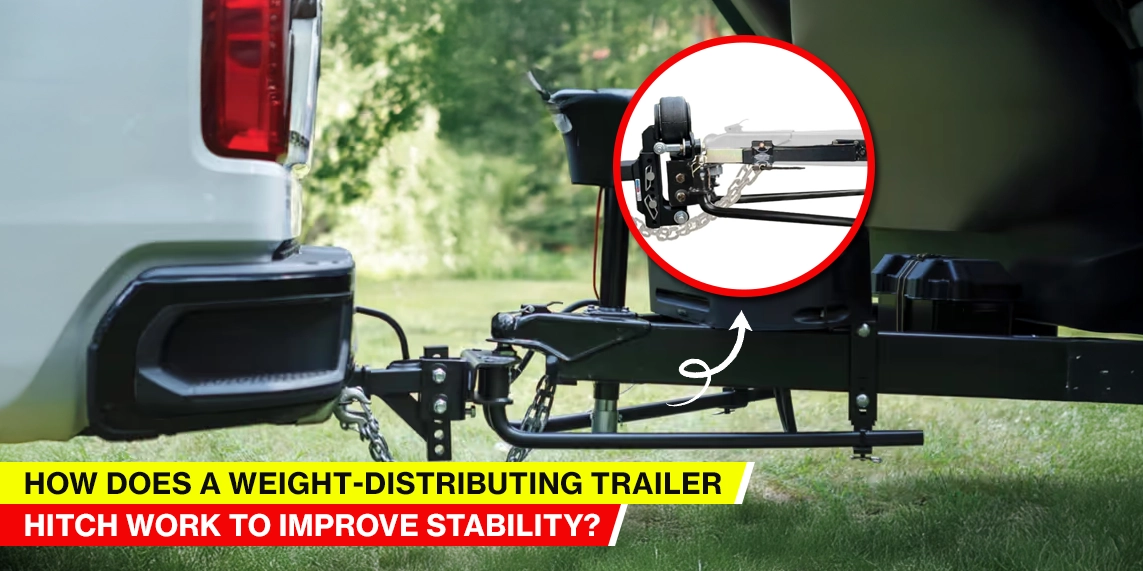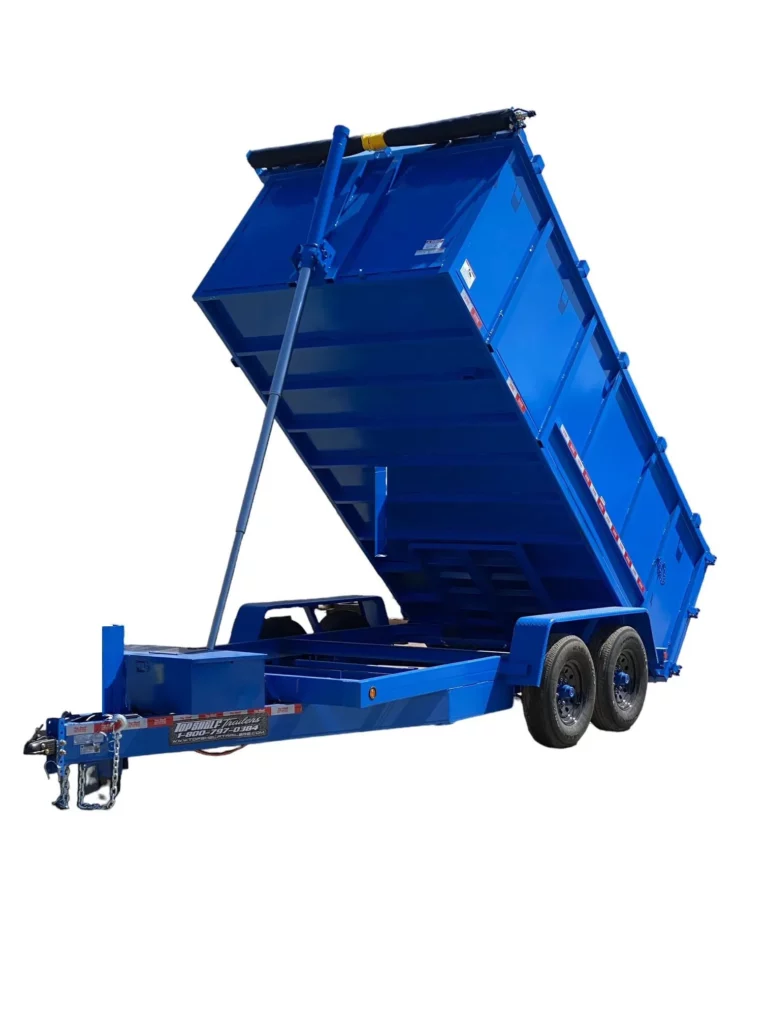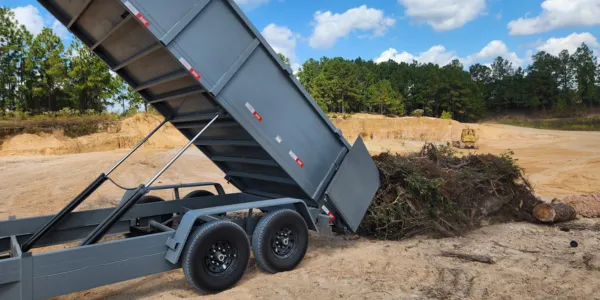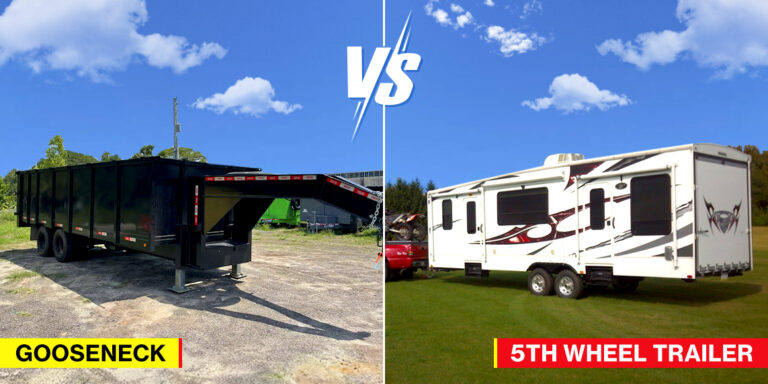Modern-day trailers have evolved transportation activities to make them simpler than ever before. A trailer can be your safe bet for shifting large cargo, moving to a new home, or carrying tools to a particular location.
If the trailer starts swinging back and forth when you are towing it, it could be a serious challenge. A malfunctioning or badly installed weight distribution hitch is a common cause of this stressful situation.
Although a standard hitch promises to tow a huge bulk, it may fail to distribute your trailer’s weight evenly. This could lead to uncontrollable swaying that makes driving risky.
Most people who have experienced such struggles invest in a weight distribution hitch. It can be a key tool for towing a trailer.
So, how does a weight-distributing trailer hitch work? In this blog, we will explain it in greater detail.
| Feature | Regular Hitch | Weight-Distributing Hitch |
| Weight Balance | Rear-heavy | Evenly distributed |
| Vehicle Level | Rear sags, front lifts | Vehicle stays level |
| Steering Control | Reduced control | Improved steering |
| Braking Efficiency | Longer stopping distance | Shorter, safer braking |
| Trailer Sway | Higher risk of sway | Sway greatly reduced |
| Ride Comfort | Rough, bouncy ride | Rough, bouncy ride |
What Is A Weight Distributing Hitch?
Ideally, you must use a weight-distribution hitch to keep the trailer’s tongue weight at a safe 10 to 15 percent of the load. This reduces the possibility of any loss of control and prevents the trailer from carrying too little weight, which can lead to uncontrollable trailer sway.
Similarly, it also prevents too much weight on the trailer. It can come in the clutch to prevent the front of the trailer from “diving,” resulting in the driver losing control.
What Does A Weight Distribution Hitch Do?
This device reduces a considerable part of the enormous stress on the trailer’s bumper during a heavy tow. You must invest in preserving the investment you made in your vehicle.
Apart from that, a weight-distributing hitch system aims to ensure safety and maneuverability. It can help the drivers effectively steer, turn, control, and brake the tandem vehicle and load. Finally, you must get them under certain circumstances to keep up with the on-road laws.
Parts of a Weight Distribution Hitch
Learning the world of trailer hitches can often feel overwhelming, like trying to read an ancient language. As a newbie, it is understandable if you struggle to grasp the intricate parts and specialized terms.
1. Ball Mount
The ball mount is vital to a trailer towing setup, supporting the trailer coupler. For easy understanding, the ball mount is the crucial link that helps the vehicle connect with the trailer.
2. Trailer Hitch
A trailer hitch often serves as the true workhorse of the towing world. As the primary connection point, it can secure and support the ball mount. It promises easy versatility, allowing you to turn your towing task into a breeze.
3. Vehicle Shank
The term’ vehicle shank’ identifies the weight distribution system or the part of the ball mounts that slides into the receiver tube of your trailer hitch. It’s a vital cog of the system, ensuring that the weight distribution system or the ball mount is adequately anchored to your vehicle.
4. Hitch Pin
Judging by its size, the hitch pin might seem like a trivial bit-part component, but its role is considerable. Without the hitch pin, the ball mount will slide out of the hitch receiver.
5. Safety Chains
In the worst-case scenario, safety chains may come in clutch if the hitch connection fails. The hitch serves as the critical safety net between the vehicle and the trailer. The chains maintain the connection, prevent the trailer from breaking free, and present a risk to others on the road.
Types of Weight Distribution Hitches
The market is saturated with an extensive range of load-equalizing trailer hitch systems. We recommend you find the ideal fit to ensure a safe towing service. All weight distribution hitches are designed to address specific trailer sizes and towing needs.
We have detailed the significant types of weight distribution hitches.
1. Round bar Weight Distribution Hitch
This is arguably the most conservative type of weight distribution hitch. It features round spring steel bars designed to be inserted into the hitch receiver to connect the trailer frame. The bars distribute weight across the trailer axles and tow vehicle.
Round bar weight distribution hitches suit medium to large trailers, including utility, travel, and horse trailers. Furthermore, they can benefit most towing situations on well-maintained roads and highways.
2. Trunnion Bar Weight Distribution Hitch
Up next are trunnion bar weight distribution hitches, which feature rectangular or square bars instead of round bars. They can be of great help and service for medium to large trailers. Unlike round bar hitches, they ensure significant ground clearance. Thus, unlike round bar weight distribution hitches, they prove to be highly suited to towing over uneven terrain.
3. Sway Control Hitch
Sway control hitches involve mechanisms to reduce trailer sway. Sway can occur due to a range of factors, including passing vehicles, wind, or improper trailer weight distribution.
Specific weight distribution systems with built-in sway control are available, with others providing it as an optional add-on. Obviously, from the name, they make the best sense for trailers with sway control issues.
4. Dual Cam Weight Distribution Hitch
They use a dual cam system for even weight distribution and swaying control. The cams are positioned on the spring bars and the trailer frame. They provide extra control and stability during towing. They make an excellent choice for medium—to large trailers, as they are more prone to swaying.
5. Chain-Style Weight Distribution Hitch
Chain-style weight distribution hitches use chains instead of bars to shift weight from the trailer tongue to the tow vehicle’s frame. They are adjustable and offer flexibility in weight distribution. They can simplify your towing process even when loads are uneven.
Benefits of a Weight Distributing Tow Hitch
Utilizing weight distribution hitches has several advantages, like improved stability, better handling and braking, and diminished wear and tear on the trailer and tow vehicle. Additionally, weight distribution hitches can assist in preventing “fishtailing, ” which occurs when the rear end of the tow vehicle swings from side to side.
We have detailed the several benefits of using a weight distribution hitch, like:
1. Improved Towing Stability
One of the most rewarding benefits of a weight distribution hitch is the stability it provides. When towing a huge bulk, improper weight distribution can cause the towing vehicle’s rear to sag, contributing to increased sway and poor handling.
A load-balancing hitch can level the vehicle and trailer, reducing the risk of sway and ensuring a safe and more comfortable journey.
2. Better Steering and Braking Control
When the weight is evenly distributed, better contact between the towing vehicle’s front wheels and the road can be expected. This increases braking efficiency and steering responsiveness, which are essential for safe towing, especially in emergencies.
3. Reduced Wear And Tear on Your Vehicle
Improper weight distribution can compromise your vehicle’s tires, rear suspension, and brakes, gradually leading to premature wear and expensive repairs. A weight distribution hitch can relieve this strain by evenly distributing the load, contributing to the longevity of your vehicle’s components.
4. Improved Fuel Efficiency
A leveled vehicle with an evenly distributed load can reduce rolling resistance and aerodynamic drag. This can result in improved fuel efficiency, saving money on long trips.
5. Versatility
Weight distribution drop hitches are available in diverse weight capacities and sizes. They are incredibly suitable for distinctive towing applications. You can find an appropriate weight distribution trailer hitch that meets your needs perfectly.
How Does A Weight Distributing Trailer Hitch Work?
It’s relatively simple but highly effective to use a weight distribution hitch. We have detailed about how to use a weight distribution trailer hitch:
1. Connection:
The hitch is positioned between the trailer’s coupler and the towing vehicle’s hitch receiver. This makes it similar in structure to a standard ball hitch.
2. Spring Bars:
Spring bars connect with the hitch and move outward to link to the trailer’s frame. They serve as levers to reallocate the weight.
3. Weight Redistribution:
Once the trailer is loaded, the spring bars provide upward pressure to the trailer’s tongue and downward pressure to the towing vehicle’s rear axle. This distributes some of the weight from the rear axle to the front axle and trailer axles to achieve a more balanced load.
An even weight redistribution can allow the weight distribution hitch to:
- Avert sagging at the rear of the towing vehicle.
- Less sway and fishtailing.
- Develop steering and braking control.
- Preserve proper headlight alignment.
What To Consider When Choosing Weight Distribution Trailer Hitch?
Identifying the right trailer hitch requires exploring several crucial factors. We recommend determining your vehicle’s towing capacity, hitch class, tongue weight, and other elements to make an educated final decision.
We have detailed these factors to pick the best trailer hitch:
1. Towing Capacity
The essential factor in identifying a trailer hitch is determining your vehicle’s towing capacity. Go through your owner’s manual or contact the manufacturer to determine the optimum weight your vehicle can safely tow. Your hitch’s towing capacity should ideally meet or exceed the trailer weight you plan to tow.
Picking a hitch with inadequate towing capacity can prove unsafe, increase wear on the vehicle, or damage the hitch. Simultaneously, identifying a hitch with excessive towing capacity could cause added expenses and compromise stability.
2. Towing Needs
We recommend identifying a hitch as per class. You might consider using a Class 1 if you seek a hitch to tow lighter items. In contrast, a Class 5 hitch could be ideal for larger payloads. You must opt for the hitch that best fits your vehicle’s capabilities and towing needs.
If you intend to travel, the ideal hitch would be a Class 3, Class 4, or Class 5. These hitches allow you to safely tow larger, heavier trailers and are generally compatible with a weight distribution hitch necessary for towing travel trailers.
3. Trailer Tongue Weight
We recommend keeping the tongue weight within the suggested limits of the hitch you opt for and your vehicle. To ensure a safe and balanced towing experience, you must ideally maintain a tongue weight of about 10% to 15% of the total trailer weight. You must consult an experienced professional to ensure the appropriate tongue weight.
4. Safety and Braking Features
Find out if your preferred trailer requires a separate braking system to comply with local laws and ensure safe towing. A handful of states have specific regulations and requirements on trailer braking, especially for trailers over a certain weight.
Also, explore safety features like integrated locking procedures to secure your hitch better and avoid theft. If you want better towing stability, we recommend safety components like weight distribution systems or anti-sway devices.
5. Durability
Go for a hitch backed by a reputable manufacturer, as they deliver durable and high-quality products. The best-in-class trailer hitch will ensure proper construction, reliable performance, and longevity. They also promise excellent customer support if you ever have any questions or concerns about their product.
Choose the Best Trailer Hitch for Your Needs at Top Shelf Trailers
The right weight distribution system can enable you to experience an uninterrupted and safe towing experience.
At Top Shelf Trailers, they can help you in the right direction. As a market leader, they deliver extensive towing solutions and hitches. Their in-house team will help you navigate industry-grade options to find the perfect fit.
All their solutions will meet your vehicle and towing needs while adhering to optimum safety and durability standards.
Top Shelf Trailers always offers affordable solutions, whether you need a trailer for heavy-duty applications or a hitch for light-duty towing.
Go through their product roster or reach out to them right after this to equip your trailer with the best hitch and accessories for a safe towing experience. They are always available to help you learn how a weight-distributing trailer hitch works.





